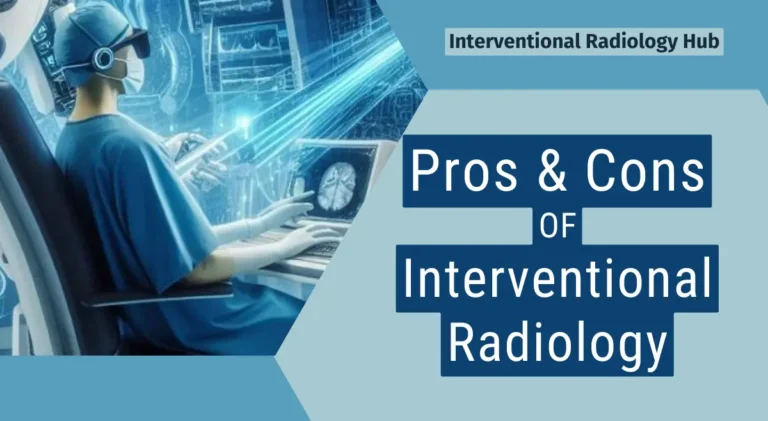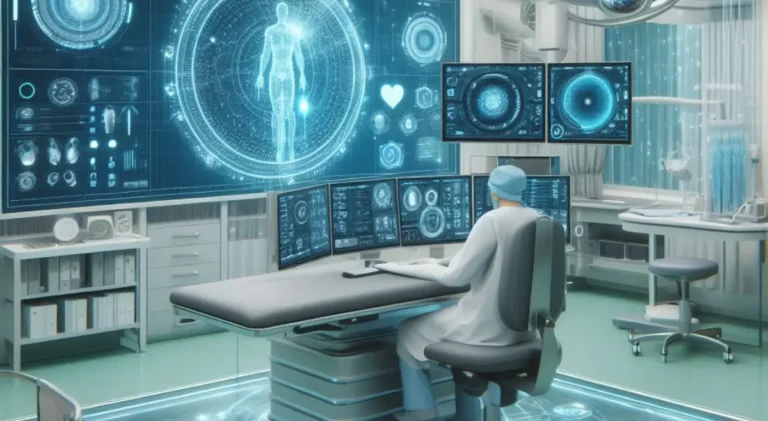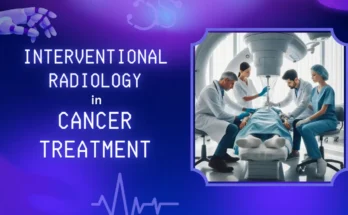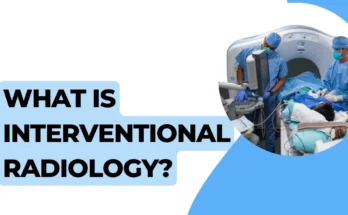
Interventional radiology offers minimally invasive treatments with quicker recovery times but can entail risks like radiation exposure and complications. Advanced imaging techniques guide procedures, which may limit surgical trauma but are not without cost and accessibility issues.
Interventional radiology stands at the forefront of modern medicine by providing innovative treatment options for numerous medical conditions. Using detailed imaging technologies, such as CT scans, MRIs, and ultrasound, interventional radiologists perform a wide range of procedures through tiny incisions, which typically leads to reduced pain and faster healing for patients.
This field has revolutionized the treatment of vascular diseases, cancer, and organ malfunctions, often providing alternatives to open surgery. Benefits include localized therapies that directly target the problem area, leading to fewer side effects and shorter hospital stays. Nevertheless, this discipline’s reliance on technology can drive up healthcare costs and necessitate specialized training for practitioners. Accessibility might also be a concern, as not all healthcare facilities are equipped with state-of-the-art interventional radiology resources. Despite these challenges, the evolving nature of this field continues to broaden the scope of treatments available, confirming its vital role in patient care.
The Rise Of Interventional Radiology
Interventional Radiology (IR) has soared in mainstream healthcare. This revolutionary medical frontier combines imaging techniques with minimally invasive procedures. It is redefining treatment options across the board.
A Brief History
The origins of IR trace back to the 1960s. Innovators looked beyond traditional imaging uses. They crafted novel ways to treat patients without open surgery. Famous breakthroughs included angioplasty and catheter-delivered stents. IR has matured into a medical norm with vast applications today.
- 1964: IR’s cornerstone with angiography’s evolution.
- 1970s–80s: Bolstered by CT and ultrasound advances.
- 1990s onward: Digital imaging and technology synergy.
Current Trends In Medical Treatments
IR stands at the forefront of modern medicine. Current trends showcase its expansive role. Patients reap benefits, such as shorter recovery times and less pain. Professionals value IR’s precision and its lower risks compared to traditional surgery.
| Trend | Impact |
|---|---|
| Outpatient Services | Maximizes comfort, minimizes hospital stay. |
| AI and Robotics | Enhances precision, reduces physician fatigue. |
| 3D Imaging | Improves diagnostics and procedure planning. |
Essential Techniques In Interventional Radiology
Interventional radiology stands at the forefront of modern medicine. It provides targeted treatments and real-time imaging. These essential techniques are transforming patient care. Let’s explore some key methods.
Image-guided Procedures
Interventional radiologists perform procedures guided by images. Images from CT scans, MRIs, and ultrasounds lead the way. They ensure precision in targeting the affected area. This accuracy reduces risks and improves outcomes.
- Angiography: Visualizes blood vessels.
- Biopsies: Extracts samples with exactness.
- Drain Insertions: Removes fluids with minimal disruption.
Minimally Invasive Methods
Patients favor minimally invasive methods. These techniques reduce hospital stays and speed up recovery. They also minimize scarring and pain.
| Technique | Benefit |
|---|---|
| Stent Placement | Opens blocked passageways. |
| Ablation Therapy | Destroys tumors without cuts. |
| Embolization | Blocks abnormal blood flow. |
Image-guided, minimally invasive methods are the core of interventional radiology. They bring hope to many facing complex conditions. This approach minimizes trauma and maximizes recovery.
Advantages Over Traditional Surgery
Interventional radiology stands as a modern medical marvel. It offers several benefits over traditional surgery. Patients can look forward to less risk and quicker recovery times. This medical innovation often comes with cost savings too. Let’s delve into the specifics.
Reduced Risk Of Complications
Interventional radiology minimizes patient risk. Procedures are typically less invasive than open surgery. This means cuts and wounds are small. Risks like infection and blood loss drop significantly. Patients with underlying health issues often find these techniques safer.
Shorter Recovery Times
- Patients bounce back quicker after interventional radiology.
- They spend less time in hospitals.
- Many return to daily activities within days, not weeks.
These procedures usually do not require general anesthesia. This can shorten hospital stays and lead to faster overall recovery.
Cost-efficiency Considerations
Interventional radiology can be gentler on your wallet than traditional surgery. Here’s why:
| Cost Factor | Traditional Surgery | Interventional Radiology |
|---|---|---|
| Hospital Stay | Longer | Shorter |
| Recovery Time | Extended | Reduced |
Shorter hospital stays and reduced aftercare often mean fewer medical bills. The use of local anesthesia or sedation, instead of general, can further cut costs.

Improving Patient Outcomes
Interventional Radiology (IR) has revolutionized patient care. This medical specialty offers minimally invasive treatments that result in better patient outcomes.
Increased Precision And Control
Interventional radiology provides greater accuracy in treatments.
- IR uses imaging techniques like MRI and CT scans.
- Doctors see inside your body with these scans.
- This view helps them treat diseases without big cuts.
Patients experience less pain and faster recoveries as a result.
Success Rates Of Common Interventions
Many IR procedures have high success rates.
| Procedure | Success Rate |
|---|---|
| Angioplasty | 90% |
| Stenting | 86% |
| Uterine Fibroid Embolization | 95% |
Statistics like these highlight the effectiveness of IR treatments.
Patient outcomes improve with these successful interventions.
Limitations And Challenges
While the benefits of interventional radiology (IR) are numerous, it’s important to also consider the limitations and challenges. This advanced medical field faces hurdles. From high-tech equipment needs to the demands of specialized training, IR is complex.
Technological Dependencies
Interventional radiology relies heavily on cutting-edge technology. This field needs up-to-date tools for accurate diagnoses and treatments. Important technology includes:
- Magnetic resonance imaging (MRI)
- Computed tomography (CT) scans
- Ultrasound machines
Such equipment is costly. Not all medical facilities can afford them. Maintenance of this technology is also expensive. It requires regular updates and repairs.
Skillset And Training Barriers
IR specialists need extensive training. Years of learning are mandatory. The training involves:
- Completing medical school
- Passing board certifications
- Undertaking fellowships in interventional radiology
It can be challenging to find suitable training programs. Even for hospitals, finding trained staff is hard. This limits access to IR services. It can delay the delivery of critical care. The demand for IR specialists can outpace supply.

Risks And Potential Downsides
Exploring interventional radiology brings us to consider not only the benefits but also the potential downsides. Safety remains paramount in medicine. Understanding the risks and limitations is crucial before proceeding with any procedure. Let’s delve into the specifics.
Complications And Limitations
Interventional radiology minimizes invasiveness but still carries its own set of risks. Below is an outline of possible complications:
- Infection: Breaks in skin integrity can invite bacteria.
- Bleeding: Even small incisions can lead to significant blood loss.
- Damage to nearby structures: Organs and tissues may suffer unintended harm.
Likewise, limitations are evident. These are some:
- Patient-specific risks such as allergies or pre-existing conditions.
- Restrictions based on the size or location of the target area.
- Technological constraints affecting procedure feasibility.
Case Studies Of Adverse Events
Learning from real-world scenarios illuminates further risks. Examples include:
| Case | Adverse Event | Outcome |
|---|---|---|
| Patient A | Contrast-induced nephropathy | Required dialysis |
| Patient B | Vascular perforation | Emergency surgery |
| Patient C | Post-procedural hemorrhage | Transient blood transfusion |
Such case studies underline the importance of weighing risks before proceeding with interventional radiology treatments.
Economic Impact On Healthcare
The economic impact of interventional radiology touches upon healthcare expenses and insurance dynamics. With technological advancements and procedural innovations, interventional radiology presents a dual-edged sword, wielding potential cost-savings but also navigating complex reimbursement landscapes. Let’s unpack these economic dimensions.
Cost-savings For Healthcare Systems
Interventional radiology, often a minimally invasive alternative to traditional surgery, can lead to substantial cost-savings for healthcare systems. Here’s how:
- Shorter hospital stays
- Less need for expensive surgical theaters
- Reduced necessity for post-operative care
- Lower rates of complications and readmissions
These factors combine to ease the financial burden on hospitals and patients alike. As a case in point, procedures like angioplasty can negate the need for costlier bypass surgeries.
Insurance And Reimbursement Issues
Despite the cost-effectiveness, insurance and reimbursement can be tricky terrain. Key points include:
- Varying coverage policies among insurers
- Complex coding for billing procedures
- Disparities in reimbursement for traditional surgery versus interventional procedures
Such issues often require careful navigation and advocacy to ensure equitable remuneration for interventional radiology services. Effective communication between healthcare providers and insurance companies is therefore paramount.
Future Directions In Interventional Radiology
As medical practices evolve, Interventional Radiology (IR) stands at the brink of an exciting future. Advancements in this field promise to enhance patient care profoundly. These future directions aim to incorporate ground-breaking techniques and improve existing treatment protocols. Let’s explore the potential shifts on the horizon.
New Technologies On The Horizon
The next wave of innovation in IR is likely to introduce game-changing technologies. These will reshape how doctors approach minimally invasive procedures.
- Artificial Intelligence (AI) – AI can analyze images quicker than humans.
- Robotic Assistance – This provides surgeons with greater precision.
- Nanotechnology – It can target treatments at the cellular level.
Potential Impact On Treatment Protocols
New technologies will yield significant shifts in treatment methods. They will make procedures safer and more effective.
| Technology | Impact |
|---|---|
| 3D Printing | Custom tools for unique patient needs. |
| Virtual Reality | Enhanced planning of surgical procedures. |
| Augmented Reality | Real-time data during procedures. |
We can expect personalized care plans with reduced recovery times. The era of one-size-fits-all treatment is nearing its end.
Conclusion
Understanding interventional radiology involves weighing its swift, minimally invasive procedures against the costs and specialized training required. Embracing this medical field could mean enhanced patient outcomes with reduced recovery time. Carefully consider these aspects to make an informed decision regarding its application in healthcare settings, always putting patient safety first.
Commonly Asked Questions about "Pros And Cons of Interventional Radiology"
- Interventional radiology offers several benefits over traditional surgery, including smaller incisions, reduced risk of complications, shorter recovery times, and minimal scarring.
- The risks of interventional radiology procedures may include bleeding, infection, allergic reactions to contrast dye, and damage to surrounding tissues or organs.
Interventional radiology procedures typically have shorter recovery times compared to traditional surgery, allowing patients to return to normal activities sooner.
- Yes, interventional radiology is particularly beneficial for treating conditions such as vascular diseases, liver diseases, kidney diseases, and certain types of cancer.
- Interventional radiologists undergo extensive training and certification to perform these specialized procedures, and their expertise can significantly impact patient outcomes.
- Yes, interventional radiology can be used in conjunction with other treatments like chemotherapy or surgery to provide comprehensive care for patients.
- Patients should consider factors such as their overall health, the specific condition being treated, potential risks and benefits of the procedure, and alternative treatment options.
- Insurance coverage for interventional radiology procedures varies depending on the specific procedure, the patient’s insurance plan, and other factors. It’s important for patients to check with their insurance provider to understand their coverage.
- Common misconceptions about interventional radiology include the belief that it’s only used for diagnostic purposes or that it’s riskier than traditional surgery. In reality, interventional radiology offers many benefits and is often a safer option for certain medical conditions.
- Interventional radiology has evolved rapidly with advancements in imaging technology, instrumentation, and techniques. Future advancements may include greater precision, enhanced imaging capabilities, and expanded treatment options for a wider range of medical conditions.


